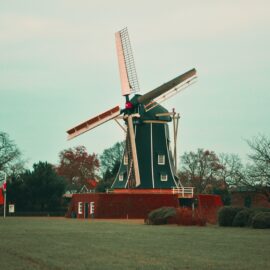

This article is an excerpt from the Shortform summary of "The Hiding Place" by Corrie ten Boom. Shortform has the world's best summaries of books you should be reading.
Like this article? Sign up for a free trial here .
What is the Beje? Is it the same as the Corrie ten Boom House? What is the home’s significance?
The Corrie ten Boom House is also known as the Beje. It was the home of the ten Boom family and served as a hiding place for Jews being persecuted by Nazis during World War 2.
Read more about the Corrie ten Boom house.
Who Lived in the Corrie ten Boom House?
The ten Boom family—father Casper, son Willem, and daughters Betsie, Nollie, and Corrie—were pillars of their community, widely respected and admired by their neighbors and friends. As long as Corrie could remember, her father and her late mother had taken in children without homes, believing that it was their Christian duty to extend their bounty to those less fortunate.
The home was always filled with children, whom the ten Booms came to regard as members of their family—scores of children passed through the ten Boom home, known as the Beje, marking the house in Corrie’s mind as a hiding place of refuge and sanctuary from a world that was often cruel and indifferent. Casper could never bear the idea of a home without children and could never close his door to a child in need. In this, the family took their inspiration from Isaiah 32:2: “And a man shall be as a hiding place from the wind, and a covert from the tempest; as rivers of water in a dry place, as the shadow of a great rock in a weary land.”
Staying at Home as a Spinster
Corrie’s mother, Cornelia, died in 1921, a few years after suffering a cerebral hemorrhage. In the years that followed, Corrie settled into life at the Beje as a dedicated spinster aunt with her sister Betsie (also a spinster) and Casper. She became the bookkeeper for her father’s watch shop, while Betsie poured herself into refurbishing the Beje. Betsie made the Beje truly glow, while opening its doors to anyone in Haarlem who wished to stop in for a hot cup of coffee, homemade soup, or Christian prayer and fellowship.
Changes After German Occupation
On May 10, 1940, Nazi Germany invaded the Netherlands, making the country’s worst fears of war and occupation a reality. It was still a stunning turn of events—not least for the pious ten Boom family. Disturbing changes began to present themselves. German uniforms and insignia became a common feature of ordinary life on the streets of Haarlem, while racist and antisemitic propaganda began to be published in once-respectable newspapers, now under the control of the Reich Ministry of Propaganda.
The Germans also ordered that all privately owned radios be handed over, in an effort to prevent the occupied Dutch population from hearing Allied broadcasts via the BBC. The ten Boom family chose to defy the confiscation order imposed on the Corrie ten Boom house radio.
Accordingly, when the German requisition officer visited the Beje to ask if the family had a radio or other contraband materials, Corrie lied and told him that they didn’t. This was one of the first moral conflicts of the war she faced. Corrie knew that lying was a sin, expressly forbidden by the Ten Commandments. But she also knew that the confiscation order was unjust and that she would be compromising another part of her and her family’s moral code to comply with it.
Safety in the Corrie ten Boom House
By May 1942, the Holocaust was in full swing, with Jews being deported en masse from German-occupied countries to labor and extermination camps in Eastern Europe. Although the full extent of what was happening to the deported Jews was not yet known by the ten Boom family, they knew that their Jewish neighbors were in grave danger.
As the war progressed, Corrie ten Boom’s house increasingly became a refuge for Jews looking to hide from Nazi persecution. Every night seemed to bring a new knock to the door, and a new person looking for refuge. The situation was becoming unsustainable: there was only so much room at the Corrie ten Boom house, and the home was situated dangerously close to the local police headquarters.
In 1942, the watch shop was not yet a full-fledged safehouse. It was instead being used as a temporary hiding place for individual Jews or Jewish families seeking refuge from the Gestapo before they could be sent to more permanent safehouses, usually in the remote Dutch countryside. Smit installed a false brick wall in Corrie’s room, behind which was to be the secret room where Jews would be able to hide.
The six Jews and the ten Booms became a true family unit. They ate, laughed, sang, and prayed together, retaining their humanity in the face of nearly unimaginable fear.
Despite the sense of community and genuine bonds of love and affection that had formed between the people living at the Corrie ten Boom house, it was still an environment fraught with fear and anxiety. If anyone on the street were to see the group gathered together for a meal, for example, it could prompt suspicion that Jews were hiding in the house. Everyone was aware of the grave dangers they faced. Any unexpected spotting by neighbors or passersby on the street necessitated quick thinking to avert suspicion.
The group had to hold regular drills to practice escaping to the hiding place in Corrie ten Boom’s house from anywhere in the house at a minute’s notice without leaving behind any trace. These drills always provoked severe anxiety, because they brought home the awful reality of what would happen if they were caught. Corrie, meanwhile, prepared herself for being questioned by the Gestapo—she needed to master the sin of lying by being able to tell the Gestapo that there were no Jews hiding at the Beje.

———End of Preview———
Like what you just read? Read the rest of the world's best summary of Corrie ten Boom's "The Hiding Place" at Shortform .
Here's what you'll find in our full The Hiding Place summary :
- Why devout Christian Corrie ten Boom decided to stand up to the Nazi occupation
- How ten Boom and the Jewish neighbors she was hiding were caught
- How ten Boom survived the concentration camp and left with even stronger faith






